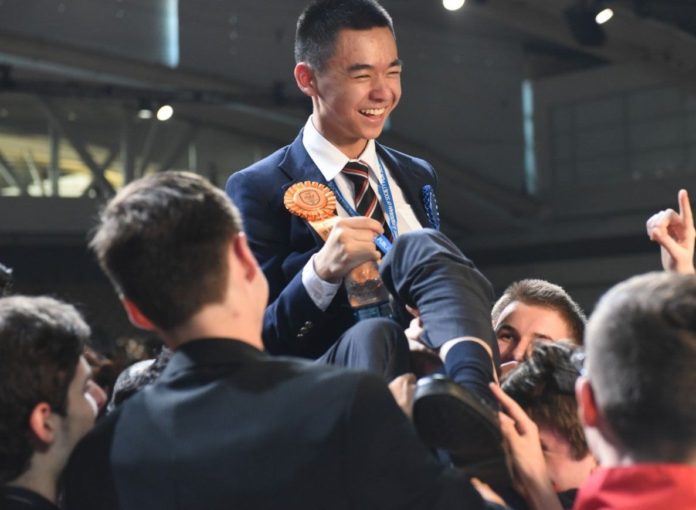Canadian student Raymond Wang, 17, won the world’s largest high school science competition on Friday, taking home the top prize of $75,000 for inventing a new way to keep germs from spreading in airplane cabins.
“It’s very exciting. I absolutely did not expect it,” Wang said by telephone from Pittsburgh, host city for the finals of the Intel International Science and Engineering Fair. “It’s literally the happiest day of my life.”
There were two runners-up in the competition.
Karan Jerath, 18, of Friendswood, Texas, received the other Intel Foundation Young Scientist Award of US$50,000 for refining and testing a novel device that should allow an undersea oil well to rapidly and safely recover following a blowout. Jerath developed a better containment enclosure that separates the natural gas, oil and ocean water; accommodates different water depths, pipe sizes and fluid compositions; and can prevent the formation of potentially clogging methane hydrate.
Nicole Ticea, 16, of Canada received one of two Intel Foundation Young Scientist Awards of US$50,000 for developing an inexpensive, easy-to-use testing device to combat the high rate of undiagnosed HIV infection in low-income communities. Her disposable, electricity-free device provides results in an hour and should cost less than US$5 to produce. Ticea has already founded her own company, which recently received a US$100,000 grant to continue developing her technology.
Wang, of Vancouver, started thinking about the problem of disease transmission on airplanes in December, after a steady stream of news about the Ebola outbreak in West Africa. Ebola is not spread through the air, he learned, but other contagious diseases — including the H1N1 “swine” flu virus and SARS virus — are spread through the air.
And that’s a problem in the cramped confines of airplane cabins, where everyone is breathing everyone else’s air.
As Wang puts it: “With the traditional cabin, what’s happening is you’ve got two large, turbulent swirls happening. You’re spreading disease across the rows and longitudinally.”
Can you say that more plainly? “When someone sneezes, there’s a mess everywhere.”
Wang said he decided to tackle the problem when he discovered that few people in the airline industry were actively working on ways to improve the quality of airplane air.
He created high-resolution simulations of airflow inside the cabin of a commercial aircraft — a Boeing 737, to be specific. And then he used those simulations to design fin-shaped devices that fit into the airplane’s existing air inlets.
The fins redirect the airflow, creating virtual walls of air around each passenger. Each person gets what Wang calls a “personalized ventilation zone” where sneezes are vanquished, pushed out of the cabin before they can spread in a turbulent burst.
His invention would improve the availability of fresh air in the cabin by 190 percent, he said, and would reduce the concentration of airborne germs by 55 times. Wang estimates that it would cost $1,000 per airplane and could be installed overnight, making it easy and economical for airlines.
And yes, he’s already filed an application for a patent.
Wang is clearly not your average high school student. He did his project not for class but on the side, and he learned what he needed to know pretty much on his own, he said. “This year I had to pick up from scratch computational fluid dynamics,” he said. “I kept going with it, watching some videos, looking at some papers.”
This is Wang’s first win at Intel’s big international fair, but it isn’t his first invention. He also invented a device that generates electricity from the impact energy of rain falling on roofs, as well as a self-cleaning outdoor garbage can. Now finishing his junior year in high school, he says he wants to study engineering and business in college.
“It’s one thing to be able to come up with these great ideas, but another thing to be able to promote them to the entire world,” he said.
Wang said he has long dreamed of competing in Intel’s international fair, and the experience has lived up to his expectations. “Basically a lot of this work is master’s or PhD-level research, and to see so many people sharing the same passions all gathered in one place, coming from across the world, is a very surreal experience,” he said.
The two runners-up each received $50,000.
—






